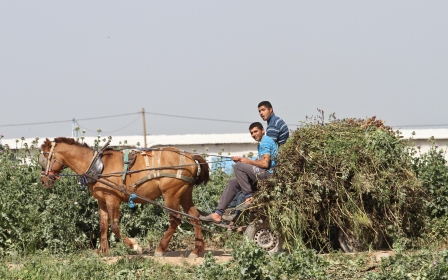The homeless Gazan, his door and the Banksy media storm

Once again, Palestinian social media activists are locked in a battle; this time with a man who owns a door which stands amid the ruins of his home. What makes this particular door unique is that it is emblazoned with one of the latest masterpieces by world-famous British artist Banksy.
Rabei Darduna, a 33-year-old father of six who lives in the northern Gaza Strip, is the owner of the door. It is one of the only parts of his home that remained standing while the rest of it was destroyed, along with the homes of tens of thousands of other Palestinians, during the violent Israeli military attacks against the strip last summer.
Darduna was surprised to see the painting by Banksy. At first he was not sure what it was, until a man offering him 700 NIS ($175) to buy the door brought the homeless man some joy and a chance of survival.
Banksy pieces regularly sell for more than $500,000 through international art dealers – a fact Darduna was not, at that time, aware of.
Darduna says he was deceived by a man who claimed to be a journalist but turned out instead to be an artist who did not tell him the true value of Banksy’s painting.
Ever since, a battle has begun, started on social media, with people naming and shaming those who covertly purchased the piece of highly politicised art.
“This door tells a truth about the suffering of people, and should be returned,” Darduna told MEE.
The painting depicted an ancient Greek god, Niobi, who weeps for the loss of her children.
The person who bought the door, Belal Khaled, said that he explained to Darduna that the door has historical value, or else, he would have bought the door for $25, instead of $175. Khaled says the door should be kept in a protected place.
“If the door remained where it was, it would lose its value among (future) re-construction or fade away in the sun, or children would paint on it,” he says. But the ethic of Banksy is that his art stays with the people it speaks out for.
Khaled says he is now trying to take the door to Arabian and international art exhibitions, where the story of Israel’s attacks on Gaza will be told.
The debate continues across Gaza as to who owns the door. Some say that the door should be owned by the public it speaks for. Darduna says he wants to give back the money and have his door back, but Khaled insists he bought the door honestly and will not return it.
Khaled, who studied fine arts, says he values such items and will ensure that it is kept for its “deserved historical value”.
As for any financial revenues for the door, Khaled says that as an ethical commitment, any profit that comes from showing this door will be shared with the owner of the demolished home.
“I will work on establishing a body for undiscovered Palestinian artists to train them and build bridges of interactions with international artists, in order to show their creative works.”
But the issue is not over yet. The debate quickly hit Facebook and Twitter, and social media users began campaigns against the buyer. Rumours swirled with some saying Banksy himself is involved and claims creator-ownership of the painted door.
However, the reality on the ground shows that Banksy never claimed ownership. The matter is only between seller and purchaser, and many social-media activists clearly don’t want such a historic treasure to be in the possession of one person as opposed to remaining in possession of the public that it was created to represent.
Mohammed Al-Baba, a Gaza-based journalist has also taken a stance saying that Banksy did a great service to the Gazans and has drawn much needed attention to the people of the besieged strip.
“The name of such a respected artist should not be brought into the middle of such fighting,” he says.
Within just a matter of hours the social-media debate has also pushed the issue to another stage, one involving lawyers and potentially the courts, with one side claiming public ownership and the other complaining that they have been publically named and shamed.
“Whatever happens, I am glad Banksy’s artwork in Gaza shows how much the Palestinians want to preserve Palestinian heritage and carry on the narrative that Banksy re-ignited,” says Al-Baba to MEE.
The controversy is unlikely to end soon but one thing is certain and that is how much young people have been inspired by the art and ethical message of Banksy’s work.
“No one should buy or sell the work of a world famous artist. He came from England in solidarity with Palestinians in Gaza and we should treasure his message” adds Al-Baba.
When asked how he would react if Bansky asks him to return the door to the family, he answered: “I would first explain to him about the inappropriate location of the painting… if he asks me to return it, I will,” he told MEE.
Stay informed with MEE's newsletters
Sign up to get the latest alerts, insights and analysis, starting with Turkey Unpacked
Middle East Eye delivers independent and unrivalled coverage and analysis of the Middle East, North Africa and beyond. To learn more about republishing this content and the associated fees, please fill out this form. More about MEE can be found here.




